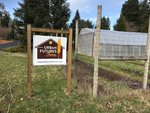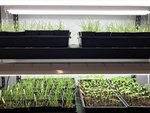

What’s the difference between gardening and agriculture? Is it size? Is it whether you sell what you grow? Neither, says TJ Johnson, the owner of the four-acre Urban Futures Farm on the outer edge of Olympia’s city limits. He says agriculture – aka farming – is “the production of food or fiber for human consumption.”
By that definition, if you plant some vegetables, you can legally adopt the farmer dress code – a very comfortable perk.
Johnson, who also chairs the Thurston Conservation District, believes we need more urban agriculture: more vegetable gardens, more community gardens, more use of vacant city-owned land to grow food, and more opportunities for residents to access fresh food close to home. He also hopes that urban food growing opportunities can educate and encourage more young people to choose farming as a profession.
Johnson is part of a group convened by the Olympia City Council’s Land Use and Environment Committee that has been discussing these hopes for three years. The group has assembled maps, studied options, looked at Olympia’s registry of vacant land, and thought about local food production from every angle.
Climate change, for instance, is among their reasons for encouraging local agriculture. Shipping food over long distances increases its carbon footprint. Locally grown food is also a hedge against disruptions in the food supply caused by droughts, floods, and other climate catastrophes.
Where does your food come from?
Johnson says no more than five percent of the food we eat is grown in Washington state, and the share grown in Thurston County is a small part of that five percent.
Yet according to the Washington State University Extension Service, “Thurston County’s farmland is rapidly disappearing. Between 1950 and 2017, the acreage of farmland as reported in the USDA Census of Agriculture declined from 170,640 acres to 62,250 acres. Between 2012 and 2017 the County experienced the 4th largest 4-yr decline since 1950 and the largest decline since 1974.”
The state Growth Management Act, passed in 1991, calls for concentrating housing and commercial development inside cities to preserve rural land. But that has not been enough to forestall shrinking farmland. Still, no net loss of county farmland is a goal the Thurston County Planning Commission is doggedly working to achieve.
Johnson doesn’t think encouraging urban agriculture will compete with or diminish rural agriculture; he believes it will be an urban amenity that makes cities more livable and thereby encourages more people to live in town. And his bottom line is that “we need all the fresh, healthy food we can grow, and we need far more people engaged in growing it.”
He is sorry to see the Spooner Berry Farm property on Yelm Highway slated to become a conventional park – and a site for another high school – rather than preserving it as city-owned farmland available to local citizens.
Johnson and others in that three-year discussion group have persuaded the city to invest more effort and money in expanding and diversifying food-growing.
The city already operates two community gardens on the westside, in which residents can sign up to use one or two 5x10-foot raised bed to grow food and flowers. Now, according to city councilmember Dani Madrone, chair of the Council’s Land Use and Environment Committee, the city is about to sign a $129,500 agreement with the Conservation District to create more.
Removing barriers to urban farming
That agreement also calls for the Conservation District to begin connecting vacant land with people looking for a place to grow food, and to analyze any remaining barriers to urban agriculture.
The Thurston Conservation District already has a rural program called Farmlink that matches people who have available land with people who want to farm, so this will be its urban analogue. We hope that its programs in town may eventually even include matching people who have extra space in big, sunny yards with people who live in nearby apartments or on small lots.
These proposals sound straightforward, but implementing them probably won’t be – because, you know, humans are involved, and we are a difficult and often unreliable species. Sometimes people start gardens and then neglect or abandon them, wasting resources and creating eyesores. For newbies, generous amounts of mentoring and training will be required.
Gardens and small farms need access to water, and that can be an issue on a vacant piece of land. And of course there are neighbors, both two-legged, four-legged, and even six-legged, who will need to be dealt with. This will be an adventure, not an entirely predictable process.
Still, it’s well worth the expense and effort to get city-dwellers off the pavement and into the green growing world. So kudos to the Conservation District and the City of Olympia, and best wishes for success and sustained community support.
Jill Severn writes from her home in Olympia, where she grows vegetables, flowers, and a small flock of chickens. She loves conversation among gardeners. Start one by emailing her at jill@theJOLTnews.com
2 comments on this item Please log in to comment by clicking here
Annierae
The city/conservation district agreement is great news! An 'urban farm link' program is a fantastic idea. I can think of numerous vacant properties on which community gardens would be a welcome facelift and, yes, the closer the food the less fossil fuel. Happy news indeed.
Saturday, March 4, 2023 Report this
sunshine39
The TCD Native plant sale is March 4 at the County fairgrounds
Board of Supervisors election is March 14; you can request a ballot by calling 369 754-3588 by March 7
or go in person to the office at 2918 Ferguson S W
Saturday, March 4, 2023 Report this